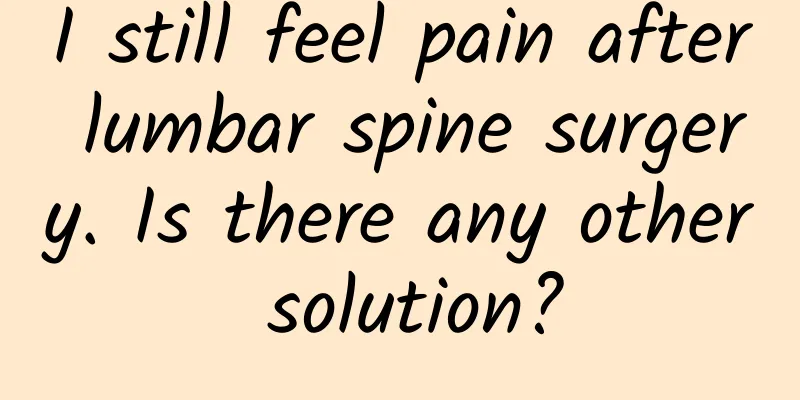I still feel pain after lumbar spine surgery. Is there any other solution?

|
The pain department often encounters such patients. Having lumbar disc herniation is already a painful thing for them. However, what is more painful is that many patients with lumbar disc herniation do not feel pain relief after surgery, and some even have new pain symptoms. They can't help but ask: the doctor said the surgery was obviously successful, why do they still have back pain and leg pain? Please let Dr. Yue tell you! What is lumbar postoperative pain syndrome? Lumbar surgery is an effective treatment for low back pain such as disc herniation, spinal stenosis, spondylolisthesis, intraspinal tumors, lumbosacral malformations, etc. However, after one or more lumbar surgeries, there is still a syndrome of persistent or recurrent low back pain, with or without sciatica, which is called postoperative pain syndrome. Causes of postoperative pain syndrome <br /> Preoperative factors: psychological factors (anxiety, depression, etc.), too high expectations. Intraoperative factors: Failure to strictly grasp the surgical indications and inappropriate selection of surgical methods. Postoperative factors: recurrence of intervertebral disc herniation, surgical complications (nerve damage, infection, hematoma, poor wound healing), lumbar instability, internal fixation failure, epidural scar, and myofascial pain syndrome. Some patients have multiple of the above reasons at the same time. Clinical manifestations of pain syndrome after lumbar surgery 1. Low back pain: mainly in the lower back or lumbar sacral region, mostly at the surgical site or adjacent to the surgical site. 2. The nature of the pain is mostly chronic dull pain. Some patients experience touch-induced pain and allodynia. The pain is more obvious at night, and cold and fatigue can aggravate the pain. 2. Low back and leg pain: The pain can be localized or radiate from the sacrum, buttocks, posterior and lateral thigh, and lateral calf to the dorsum or sole of the foot. Patients with high intervertebral disc lesions experience pain in the front thigh, and some even experience lower abdominal pain. 3. Nerve function damage: The muscles of the waist and hips and the muscles innervated by the affected nerves may atrophy, weaken, and even cause foot drop. If the cauda equina is compressed, it may cause sphincter and sexual dysfunction, manifested as urinary retention, difficulty in defecation and urination, and male patients may develop impotence. 4. After the operation, the patient finds that the original pain symptoms continue to exist or reappear or even worsen after a brief relief, or pain appears in new parts of the body. Most of the pain is persistent and can easily cause psychological disorders such as anxiety and depression. Treatment of pain syndrome after lumbar spine surgery Conservative treatment: Drug treatment: nonsteroidal anti-inflammatory drugs, tramadol, etc. Patients with neuropathic pain can take gabapentin or pregabalin. Patients with moderate to severe pain are suitable for opioids. Among them, the treatment of osteoporosis cannot be ignored. On the basis of adequate calcium and vitamin D supplementation, drugs such as calcitonin or denosumab can be considered to enhance the efficacy. Physical therapy: Exercise therapy combined with professional rehabilitation exercises, massage, acupuncture, electrotherapy, shock wave therapy, polarized light therapy, etc. can be used in combination. Kinesiotherapy taping is also an effective method to improve lumbar myofascial contracture and neuromuscular dysfunction. Psychotherapy: Long-term pain can bring serious psychological burden to patients, and necessary psychological treatment can relieve physical pain to a certain extent. Minimally invasive spinal interventional therapy: Commonly used treatment methods include radiofrequency thermocoagulation, low-temperature plasma ablation of the posterior branch of the lumbar nerve, transforaminal pulsed radiofrequency, collagenase, ozone release, etc. The appropriate treatment method can be selected according to the patient's specific situation. The above treatments can relieve most of the symptoms of patients with milder symptoms, but for patients with severe pain and numbness, the effect often requires multiple treatments to be effective. Some patients may still have residual symptoms after multiple treatments. Spinal cord electrical stimulation therapy is a new option for the treatment of postoperative lumbar pain syndrome! Spinal cord stimulation (SCS) is an effective treatment for postoperative lumbar spine syndrome (FBSS). The principle is to send weak electrical pulses through an implanted device to stimulate specific dorsal segments of the spinal cord. At the spinal cord level, the pain transmitted by the peripheral sensory nerves is replaced by a tolerable numbness, thereby blocking the pain from being transmitted to the brain center and achieving the effect of relieving pain. SCS combined with the aforementioned methods for comprehensive treatment will play a more positive role in relieving pain symptoms, improving physical functions and improving the quality of life. It should be noted that the key to FBSS treatment is to conduct a detailed analysis of common postoperative causes and to provide comprehensive treatment from multiple angles. There are many causes of FBSS, and the symptoms are not limited to pain. From both the patient's and the doctor's perspective, it is important to avoid blindly performing a second surgery or blindly destroying the sensory nerves, which will increase the complexity of subsequent treatment. Source: Pain Department, Xuanwu Hospital |
>>: Scoliosis: The many types you never knew about
Recommend
Why is the puppy shaking and his limbs weak? Is it normal for a puppy to lift its hind legs when running?
Many people will choose to buy a puppy and raise ...
Standard weight for girls 155cm tall
Contemporary women's fashion pursues a perfec...
Follow Liu Genghong, have you really lost weight? Doctors recommend: These 7 "eating" methods for medical nutrition weight loss are reliable and effective
If you don't lose weight in March, you will r...
Can pregnant women eat black dates?
When a woman becomes pregnant, her body will unde...
Popularize the early screening of cervical cancer
1. What is cervical cancer? Cervical cancer is on...
What shape of follicle is good quality
For women to ensure normal fertility, the egg mus...
Left lower abdominal pain female
If a woman has long-term left abdominal pain, and...
Treatment of cervical cancer, cervical cancer threatens women's life and health
Cervical cancer is a gynecological disease that i...
Can I see the gestational sac on 35-day ultrasound?
When you are 35 days pregnant, you are already on...
Can high prolactin lead to pregnancy? Infertility should be taken seriously
The most typical manifestation of high prolactin ...
Parents, please note! Incorrect pen-holding posture can easily lead to myopia in children
Many parents think that whether a child holds a p...
What should I pay attention to when checking vaginal ultrasound?
Although in the eyes of many women, vaginal ultra...
Can I insert an IUD immediately after IUD removal?
Compared with contraceptive measures such as cond...
What are the risks of hysteroscopy?
Hysteroscopic technology is an advanced gynecolog...
Should nails be cut into round or square shapes? How short should they be cut? I didn’t expect there are so many things to know about nail cutting
Cut your nails Different people have different cu...









